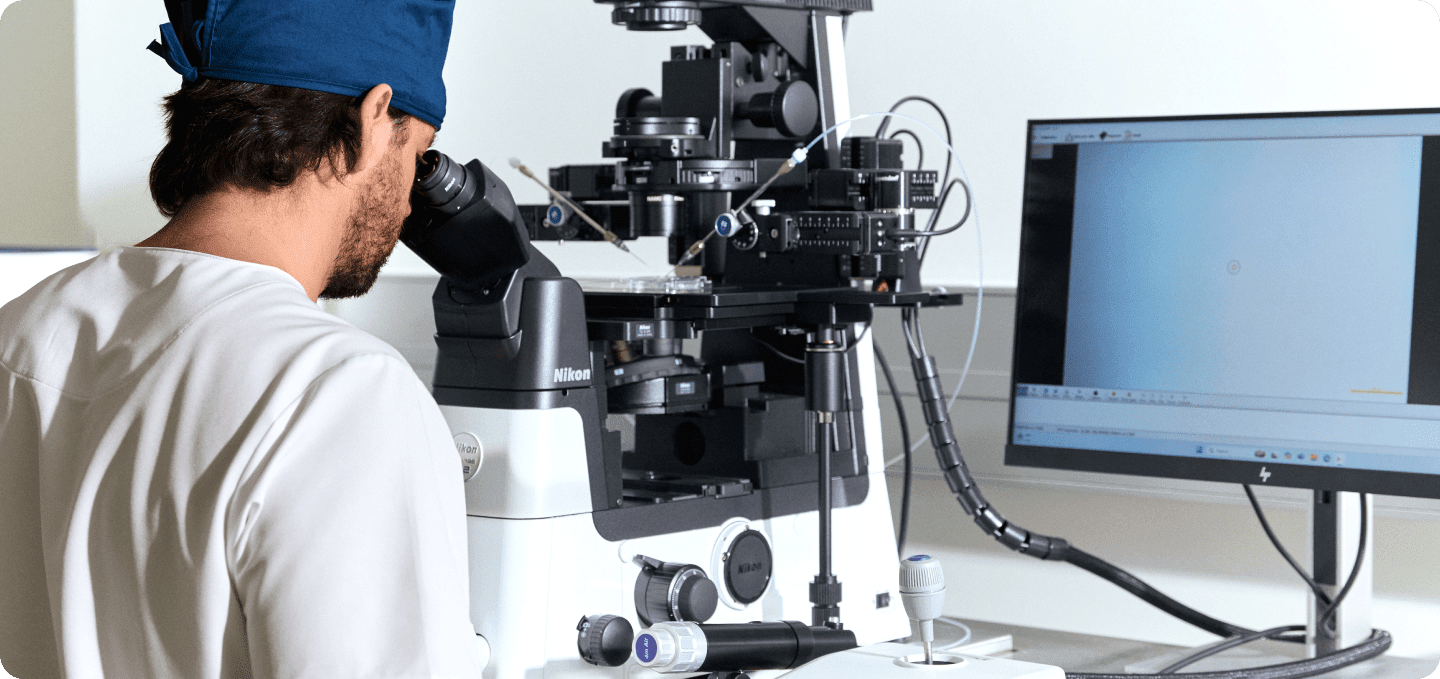Learn how to naturally and medically support embryo implantation – from hormones and cycle tracking to nutrition, IVF, PGT, and the ERA test.
Everything You Need to Know About Supporting Implantation:
- Successful implantation requires optimal uterine receptivity.
- The hormone progesterone is the most crucial factor for stabilizing and thickening the lining.
- Genetically unhealthy embryos are the main cause of implantation failure and infertility.
- Preimplantation Genetic Diagnosis (PGD) helps to increase the chance of implantation and a subsequent live birth.
- Obstacles such as fibroids or endometriosis in the uterus cavity can prevent implantation by affecting endometrial morphology.
How You Can Actively Support Implantation
Many couples experiencing infertility wonder how they can boost their chances of pregnancy. This puts one critical step in the spotlight: implantation (medically known as nidation).
After the egg is fertilized following ovulation, it undergoes embryo development and travels through the fallopian tubes to the uterus, where it arrives as a blastocyst. For a successful pregnancy, this blastocyst must embed itself in the optimally prepared uterine lining. This process is biologically complex and precisely controlled by hormonal regulation involving progesterone and hCG.
The good news is that you can actively support this process.
In this article, you’ll learn which strategies can promote implantation, help you avoid common obstacles, and optimize your fertility through diet, lifestyle, and modern medical approaches.

The Process of Implantation
To promote implantation means to best support the natural sequence of events. Embryo implantation normally begins between the 5th and 7th day after fertilization. The uterine lining undergoes decidualization and thickens after ovulation in the second half of the cycle under the influence of progesterone and estrogen, optimizing conditions for nidation.
Around the 6th day after fertilization, the blastocyst reaches the uterus. This is where implantation occurs, during which the fertilized egg burrows deep into the uterine lining (endometrium). This process can be accompanied by slight contractions, a mild pulling sensation, or minimal bleeding. A successful implantation activates the production of the hCG hormone, which stabilizes an early pregnancy and is detectable via a blood test or urine test, sometimes leading to biochemical pregnancies if it doesn't progress.
Factors Influencing Implantation
To successfully promote implantation, it’s important to understand the various inner and outer factors that influence uterine receptivity.
Hormonal Balance
A stable hormonal balance, reflecting hormonal stability, with sufficient progesterone and estrogen is crucial. Low progesterone levels or a shortened luteal phase can reduce the chances of successful nidation and are often corrected with hormonal support.
Uterine Lining and Uterine Wall
A well-developed lining with optimal endometrial morphology and good endometrial-subendometrial blood flow is a prerequisite for implantation. Changes due to fibroids, polyps, or endometriosis can make it difficult and compromise uterine receptivity.
Lifestyle and Nutrition
A balanced diet with important prenatal vitamin components (including Vitamin D, iron, Omega-3 fatty acids) and antioxidants, adequate sleep, and less emotional stress positively affect fertility and cellular health. A regular cycle also supports hormonal regulation.
Medical Influences (Timing)
In assisted reproduction, such as in vitro fertilisation (IVF) or ICSI, and especially in a frozen embryo transfer (FET), doctors at the fertility clinic pay close attention to the optimal timing of the implantation phase. Even small deviations can lead to implantation failure or recurrent implantation failure. Techniques like EmbryoGlue, containing hyaluronan, may be used to enhance attachment.
Egg and Embryo Quality
Problems hindering embryo development reduce the chances of implantation. These include disrupted egg maturation (affecting embryo development), a genetic defect of the embryo itself, or a too-thick zona pellucida (which can be addressed with assisted hatching). Sperm quality is also a key factor; DNA damage in the sperm can result in non-viable embryos that won't implant. Specialists like an embryologist use special laboratory techniques such as ZyMot-ICSI to improve selection.
Learn more about how to support implantation in this video:
Six Best Strategies to Promote Implantation
1. Optimize Nutrition: Micronutrients and Omega-3
When aiming to promote implantation, a holistic approach combining diet, lifestyle, and medical guidance is worthwhile. Recent analysis shows that increased intake of Omega-3 fatty acids is associated with a significantly elevated pregnancy and fertilization rate—both in natural conception and in IVF treatment cycles.
In a study with women undergoing ICSI, Omega-3 supplementation led to an increase in mature eggs, a better fertilization rate, and a higher number of top-quality embryos.
These findings suggest that a targeted diet with Omega-3 fatty acids, along with a sufficient supply of prenatal vitamin components like folic acid, iron, and Vitamin D, promotes better endometrial receptivity (thicker lining, better endometrial-subendometrial blood flow).

2. Stress Reduction: Inner Calm for Better Receptivity
Emotional stress can play an important role in implantation failure. Studies show that strong or persistent emotional stress can make the uterine lining less receptive to the embryo. The release of stress hormones disrupts the body's delicate biological processes, potentially affecting hormonal stability and uterine receptivity. Relaxation exercises, yoga, walks, meditation, or acupuncture can help calm the body and stabilize hormonal regulation.

3. Progesterone: Key Hormone for Stable Implantation
Hormones are crucial for implantation. Specifically, progesterone prepares the uterine lining for the embryo and ensures a stable, well-vascularized environment—ideal conditions for embryo implantation. Low progesterone levels or a short luteal phase can complicate implantation. In such cases, hormonal support with progesterone is often part of fertility treatment to build up and stabilize the lining.
Experts emphasize that the timing and dosage of hormone therapy must be carefully coordinated to avoid altering the "implantation window." If progesterone is administered too early, it can shift this critical window when the lining is most receptive, meaning the embryo and uterus may not synchronize optimally.
4. Testing Endometrial Receptivity: Determining the Implantation Window
For women with recurrent implantation failure despite multiple embryo transfers, specialists often recommend advanced endometrial receptivity tests to assess uterine receptivity.
Modern diagnostics, like genetic analysis of the lining (e.g., the ERA test), can pinpoint the ideal timing for embryo implantation—the "implantation window." This information allows for individually tailored hormone therapy, ensuring the embryo transfer is precisely timed to the most receptive period.
Research confirms the relevance of this approach. A meta-analysis showed that personalized fertility treatment based on these tests, known as personalized embryo transfer (pET), tends to yield higher clinical pregnancy rates and better live birth rates compared to standard transfers in patients with recurrent implantation failure.
5. PGD: Increasing Implantation Chances Through Embryo Screening
A majority of failed implantations stem from chromosomal defects in the embryo, leading to poor embryo development. The body rejects the embryo even if the uterine lining is optimally prepared. Preimplantation Genetic Diagnosis (PGD), or pre-implantation genetic testing (PGT), directly addresses this.
As part of IVF treatment, an embryologist takes a tiny cell sample from the blastocyst in a process often called blastocyst transfer. This is tested for genetic irregularities. Only euploid embryos are transferred into the uterus. This selection process significantly increases the chance of successful implantation and a subsequent live birth, while reducing the risk of early pregnancy loss or recurrent miscarriages.

6. Personalized Strategies in the Fertility Clinic
When recurrent implantation failure has occurred, or the uterine lining is unusually thin, close medical supervision is essential. Doctors in a fertility clinic use ultrasound and blood tests to monitor lining thickness, endometrial-subendometrial blood flow, and progesterone levels throughout the cycle to determine the ideal timing for the embryo transfer or frozen embryo transfer (FET).
An effective medical strategy combines clinical experience, advanced diagnostics, and personalized therapy, maximizing the chances to promote implantation and achieve positive pregnancy outcomes.
Anyone who wants to promote implantation should consider all influencing factors: good nutrition, stress reduction, and medical control work together more effectively than any single measure for successful IVF treatment.
Good nutrition is essential for successful implantation after ovulation or IVF. This podcast explores how a balanced diet can enhance your fertility and increase your chances of success.
Modern Diagnostics and Personalized Therapy Can Improve Implantation
Embryo implantation is a finely tuned process where egg cells, sperm, and hormones must interact perfectly. While this moment cannot be completely controlled, couples experiencing infertility can contribute significantly to promote implantation with a healthy lifestyle, conscious nutrition (including a prenatal vitamin), and medical guidance.
The IVF treatment journey sometimes requires patience and trust, but modern reproductive medicine shows that science and hope can go hand-in-hand. Each treatment is a step closer to the goal to having a child.
Ready to take the next step on your fertility journey?
The Cada Clinic in Zürich is here to support you: Our specialists in fertility medicine use modern diagnostics and personalized therapy to optimize your chances of implantation.
Book your free consultation now to take a step closer to making your dream of a child a reality.
FAQ About Supporting Implantation
How can I promote implantation naturally?
A balanced diet, sufficient sleep, and stress reduction can promote implantation. Omega-3 fatty acids, folic acid, Vitamin D, and iron (often found in a good prenatal vitamin) are especially helpful as they improve blood flow and the development of the uterine lining, supporting uterine receptivity.
Regular exercise, a stable cycle, and avoiding smoking and alcohol consumption also support fertility and thus the chances of successful implantation. Meditation and acupuncture are complementary stress reduction methods often employed.
What role do hormones play in implantation?
Progesterone prepares the uterus for the embryo and ensures a stable lining. After successful implantation, the body produces the hormone hCG, which maintains the pregnancy. An unbalanced hormone status—often detected by monitoring progesterone levels—can disrupt implantation. Hormonal regulation is key, and an in vitro fertilisation cycle often includes hormonal support.
Can stress prevent implantation?
Yes. Emotional stress can complicate implantation as stress hormones can make the uterine lining less receptive, negatively impacting endometrial receptivity. Persistent tension disrupts hormonal stability and can negatively affect implantation. Stress reduction methods like meditation, yoga, walks, or breathing exercises help improve implantation chances and overall quality of life.
When is it considered implantation failure?
Implantation failure (or recurrent implantation failure) is defined when no pregnancy results despite repeated embryo transfers and good embryo quality, often leading to infertility. In such cases, fertility clinics perform special investigations—such as endometrial receptivity tests or pre-implantation genetic testing—to specifically find out why the embryo could not implant.
How can a fertility clinic support implantation?
A fertility clinic can promote implantation through modern diagnostics and targeted therapy as part of fertility treatment. Specialists check progesterone levels, egg quality, sperm quality, and the state of the endometrium. With ultrasound, blood tests, or specialized procedures like the ERA test, the optimal time for the embryo transfer or blastocyst transfer can be determined. The treatment is individually tailored to the cycle and endometrial receptivity to achieve the best pregnancy outcomes and a live birth. Sometimes, the immune system is assessed for issues like antiphospholipids.







